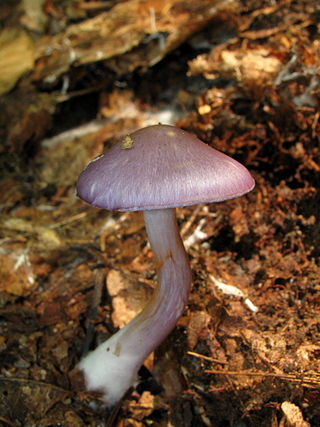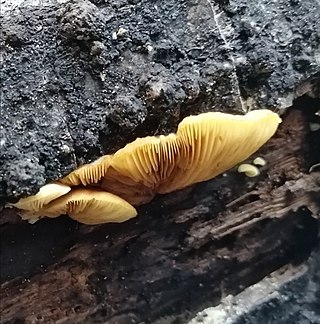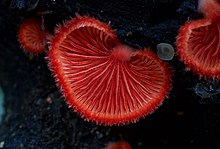
Hygrocybe punicea is a species of agaric in the family Hygrophoraceae. It has been given the recommended English name of crimson waxcap. The species has a European distribution, occurring mainly in agriculturally unimproved grassland. Threats to its habitat have resulted in the species being assessed as globally "vulnerable" on the IUCN Red List of Threatened Species. Records of H. punicea from North America, East Asia, and Australia require further research to see if they represent the same species.
Gymnopilus luteus, known as the yellow gymnopilus, is a widely distributed mushroom-forming fungus of the Eastern United States. It contains the hallucinogens psilocybin and psilocin. It is often mistaken for G. speciosissimus and G. subspectabilis.

Crepidotus versutus, commonly known as the evasive agaric, is a species of fungus in the family Crepidotaceae. It is saprobic on wood, like other Crepidotus species, but it can also decompose herbaceous forest litter. The species is characterized by large, punctate, ellipsoid spores, and the white, hairy pileus.

Cyptotrama asprata, commonly known as the golden-scruffy collybia or spiny woodknight is a saprobic species of mushroom in the family Physalacriaceae. Widely distributed in tropical regions of the world, it is characterized by the bright orange to yellow cap that in young specimens is covered with tufts of fibrils resembling small spikes. This fungus has had a varied taxonomical history, having been placed in fourteen genera before finally settling in Cyptotrama. This species is differentiated from several other similar members of genus Cyptotrama by variations in cap color, and spore size and shape.

Crepidotus mollis, commonly known as the peeling oysterling, soft slipper, jelly crep, or flabby crepidotus, is a species of mushroom. It's edibility is unknown, but it is probably inedible and possibly poisonous.

Cortinarius varius, also known as the contrary webcap, is a basidiomycete mushroom of the genus Cortinarius. The mushroom has orangish-yellow caps that reach up to 10 cm (3.9 in) in diameter, and thick club-shaped stems up to 10 cm (3.9 in) long.

Cortinarius anomalus, also known as the variable webcap, is a basidiomycete fungus of the genus Cortinarius. It produces a medium-sized mushroom with a grayish-brown cap up to 5 cm (2 in) wide, gray-violet gills and a whitish stem with pale yellow belts below. The mushroom grows solitarily or in scattered groups on the ground in deciduous and coniferous forests. It is found throughout the temperate zone of the northern hemisphere.

Cortinarius vanduzerensis is a species of mushroom in the family Cortinariaceae. Described as new to science in 1972, it is known only from the Pacific Northwest region of North America, where it grows under conifers such as spruce, hemlock, and Douglas-fir. The fruit bodies of the fungus, or mushrooms, have a slimy dark chestnut-brown cap that becomes deeply radially grooved or corrugated in maturity, and reaches diameters of up to 8 cm. The gills on the underside of the cap are initially pinkish-buff before becoming pale brown when the spores mature. The stem is lavender, measuring 10–18 cm (4–7 in) long and 1–2 cm thick. The mushroom produces a rusty-brown spore print, with individual spores measuring 12–14 by 7–8 micrometers. The edibility of the mushroom has not been determined, and it has been described as "much too slippery to be of value".

Cortinarius iodes, commonly known as the spotted cort or the viscid violet cort, is a species of agaric fungus in the family Cortinariaceae. The fruit bodies have small, slimy, purple caps up to 6 cm (2.4 in) in diameter that develop yellowish spots and streaks in maturity. The gill color changes from violet to rusty or grayish brown as the mushroom matures. The species range includes eastern North America, Central America, northern South America, and northern Asia, where it grows on the ground in a mycorrhizal association with deciduous trees. The mushroom is not recommended for consumption. Cortinarius iodeoides, one of several potential lookalike species, can be distinguished from C. iodes by its bitter-tasting cap cuticle.

Hygrocybe splendidissima, is a species of agaric in the family Hygrophoraceae. It has been given the recommended English name of Splendid Waxcap. The species has a European distribution, occurring mainly in agriculturally unimproved grassland. Threats to its habitat have resulted in the species being assessed as globally "vulnerable" on the IUCN Red List of Threatened Species.

Entoloma porphyrophaeum is a species of agaric in the family Entolomataceae. It has been given the recommended English name of Lilac Pinkgill. The species has a European distribution, occurring mainly in agriculturally unimproved grassland. Entoloma porphyrophaeum has been reported from North America, but at least some of these reports represent a distinct species, Entoloma canadense. Threats to its habitat have resulted in the Lilac Pinkgill being assessed as globally "vulnerable" on the IUCN Red List of Threatened Species.

Entoloma griseocyaneum is a species of agaric in the family Entolomataceae. It has been given the recommended English name of Felted Pinkgill. The species has a European distribution, occurring mainly in agriculturally unimproved grassland. Threats to its habitat have resulted in the Felted Pinkgill being assessed as globally "vulnerable" on the IUCN Red List of Threatened Species.

Crepidotus praecipuus, is a species of fungus in the family Crepidotaceae first described in 2018. It is commonly known as a rusty-gilled conch, along with other kidney shaped, rusty-brown spored species of Crepidotus. It is saprobic on wood, like other Crepidotus species.

Crepidotus variabilis is a species of saprophytic fungi in the family Crepidotaceae. It is commonly known as a variable oysterling in the United Kingdom and is seen there in autumn. May occur solitary, but more often in small scattered groups from summer to autumn on twigs and other woody debris of broad-leaved trees. Very common but often confused with Crepidotus cesatii.

Crepidotus epibryus, is a species of saprophytic fungi in the family Crepidotaceae. It is commonly known as grass oysterling in the United Kingdom and is seen there in late summer and autumn.

Crepidotus affinis is a species of saprophytic fungus in the family Crepidotaceae with a stipeless sessile cap. The fungus was described by Egon Horak in 2018 and has been found in New Zealand, Panama, and the Philippines.

Crepidotus brunnescens, is a species of saprophytic fungus in the family Crepidotaceae with a stipeless sessile cap which is smooth and yellowish-brown. It is often found on hardwood logs such as Quercus.

Crepidotus cesatii, commonly known as the roundspored oysterling, is a species of saprophytic fungus in the family Crepidotaceae with a stipeless sessile cap. It is often found on woody and herbaceous plant debris from many different hosts including conifers, appearing from late summer to winter usually in small scattered groups. Often confused with Crepidotus variabilis, it can be distinguished by its different spores.
Leucocoprinus straminellus is a species of mushroom producing fungus in the family Agaricaceae. Like other Leucocoprinus species it may have originated in a tropical climate but now finds a home in plant pots, greenhouses and compost piles in many countries. Leucocoprinus straminellus is described as being similar to the more commonly known Leucocoprinus birnbaumii but it is smaller and a lighter shade of yellow with smaller spores that lack a germ pore. It is also described as being superficially similar to Leucocoprinus fragilissimus but slightly more robust with flesh that is less translucent.
Pseudotricholoma metapodium is a species of agaric in the family Tricholomataceae. It has been given the recommended English name of mealy meadowcap. The species has a European distribution, occurring mainly in agriculturally unimproved grassland. Threats to its habitat have resulted in the mealy meadowcap being assessed as globally "endangered" on the IUCN Red List of Threatened Species.

















